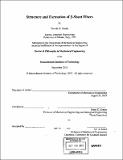| dc.contributor.advisor | Roger D. Kamm. | en_US |
| dc.contributor.author | Marini, Davide M. (Davide Maurizio), 1968- | en_US |
| dc.contributor.other | Massachusetts Institute of Technology. Dept. of Mechanical Engineering. | en_US |
| dc.date.accessioned | 2006-03-24T18:09:39Z | |
| dc.date.available | 2006-03-24T18:09:39Z | |
| dc.date.copyright | 2003 | en_US |
| dc.date.issued | 2003 | en_US |
| dc.identifier.uri | http://hdl.handle.net/1721.1/29990 | |
| dc.description | Thesis (Ph. D.)--Massachusetts Institute of Technology, Dept. of Mechanical Engineering, 2003. | en_US |
| dc.description | Includes bibliographical references. | en_US |
| dc.description.abstract | The spontaneous organization of protein monomers into fibers, bundles and networks is central to biology. Inspired by the repetitive patterns found in the amino acid sequence of natural fibrous proteins, short peptides have been designed to self-assemble in aqueous solution into gelatinous matrices. Such hydrogels appear under the electron microscope as networks of finely interwoven fibers and have demonstrated great potential for tissue engineering applications. This thesis addresses the experimental and theoretical characterization of this self assembly process at the molecular scale. Structural characterization of single fibers from these hydrogels was performed to elucidate their molecular architecture and self-assembly mechanism. In the case of the molecule mainly studied in this research (KFE8), atomic force microscopy and quick-freeze/deep-etch revealed that mature fibers are formed through intermediate steps in which the fiber structure (a left-handed helical ribbon of diameter ~ 7 nm and helical pitch ~ 19 nm) differs markedly from its final form (tubular). These results, in conjunction with molecular dynamics simulations and circular dichroism, suggest that such intermediates are comprised of two helical P-sheet layers that sandwich hydrophobic side chains in between them. Small variations in amino acid side chains were also found to have substantial effects on fiber structure and self-assembly. The kinetics of matrix self-assembly were elucidated by means of an analytical treatment and numerical simulations. A Smoluchowski-type mean-field description of fiber nucleation and growth was developed to relate average fiber length to the fundamental rate constants of the process: in the limit of the elongation rate constant being much larger than the nucleation rate constant, the average fiber length was found to be proportional to the square root of their ratio. A Brownian dynamics model was also developed, based on explicit description of particle motion, allowing simulation of fiber self-assembly in conditions where diffusion becomes a limiting factor. The average fiber length computed from simulations was shorter than the one predicted analytically. In order to explain such discrepancy, a scaling argument was developed that takes into account the inhomogeneities introduced in the system by the process of self-assembly. | en_US |
| dc.description.statementofresponsibility | by Davide M. Marini. | en_US |
| dc.format.extent | 164 p. | en_US |
| dc.format.extent | 10873902 bytes | |
| dc.format.extent | 10873709 bytes | |
| dc.format.mimetype | application/pdf | |
| dc.format.mimetype | application/pdf | |
| dc.language.iso | eng | en_US |
| dc.publisher | Massachusetts Institute of Technology | en_US |
| dc.rights | M.I.T. theses are protected by copyright. They may be viewed from this source for any purpose, but reproduction or distribution in any format is prohibited without written permission. See provided URL for inquiries about permission. | en_US |
| dc.rights.uri | http://dspace.mit.edu/handle/1721.1/7582 | |
| dc.subject | Mechanical Engineering. | en_US |
| dc.title | Structure and formation of β-sheet fibers | en_US |
| dc.title.alternative | Structure and formation of beta-sheet fibers | en_US |
| dc.type | Thesis | en_US |
| dc.description.degree | Ph.D. | en_US |
| dc.contributor.department | Massachusetts Institute of Technology. Department of Mechanical Engineering | |
| dc.identifier.oclc | 54792716 | en_US |
